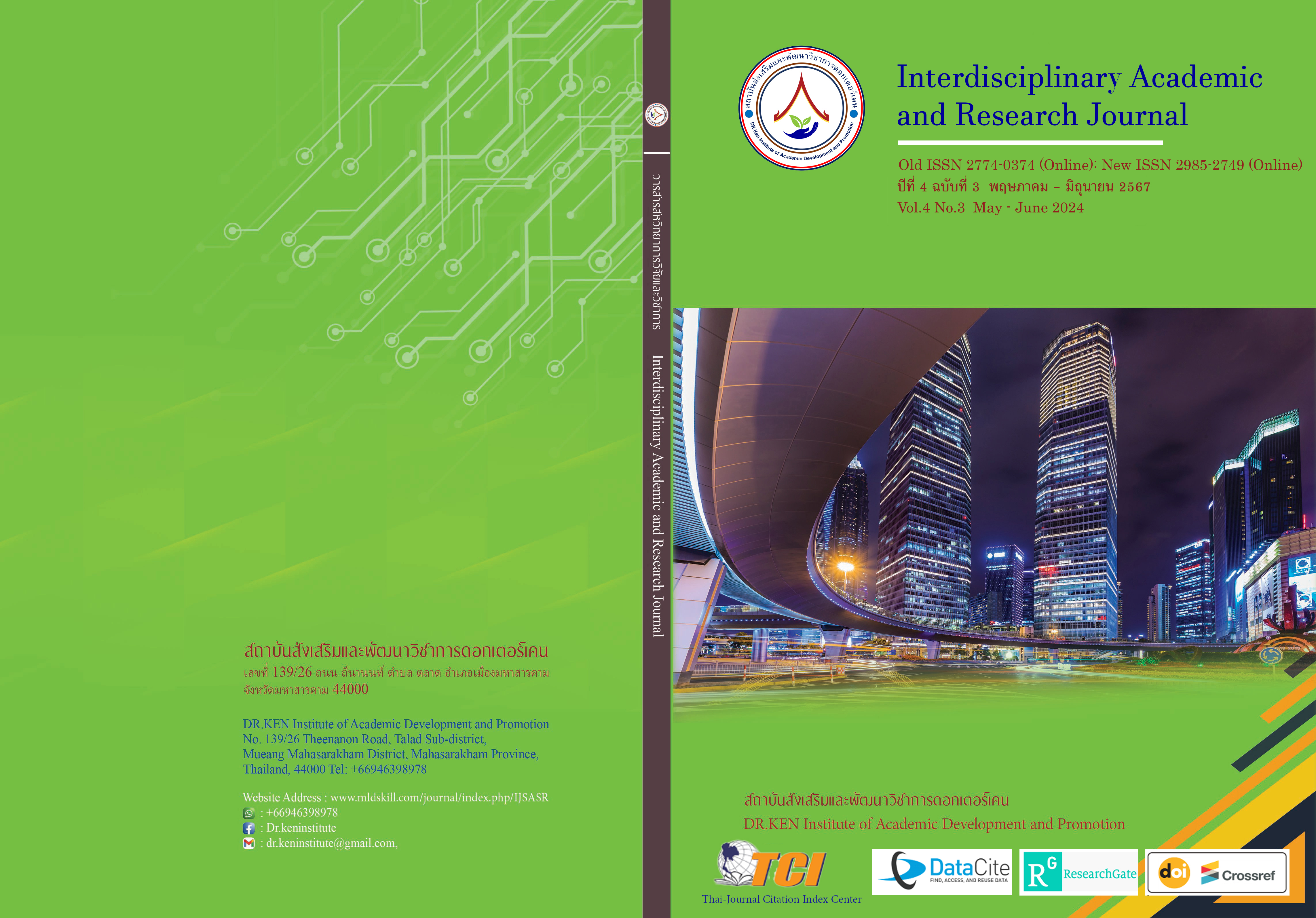Development Guidelines for Visionary Leadership of School Administrators under the Office of Maha Sarakham Primary Educational Service Area 3
DOI:
https://doi.org/10.60027/iarj.2024.275478Keywords:
Guidelines for Developing; , Visionary Leadership; , School AdministratorsAbstract
Background and Aims: Visionary leadership is the ability of a leader to thoroughly understand the organization's circumstances, and clearly define the roles and direction of the organization. The capacity to disseminate ideas that inspire employees to embrace them and lead the organization towards the appropriate and fitting direction and ready to embrace changes and competition that arise. School administrators are considered crucial individuals for the development of the organization. Because administrators drive the organization toward its desired direction efficiently and effectively. Therefore, this research aims to study the current desirable state and the priority need for the visionary leadership of school administrators under the office of Maha Sarakham Primary Educational Service Area 3 and to study the guidelines for developing visionary leadership of school administrators under the office of Maha Sarakham primary educational service area 3
Methodology: The research procedures were divided into two phases. The first stage was to study the current desirable state and the priority need of visionary leadership of school administrators, The sample group consists of 285 individuals, comprising 40 school administrators and 245 teachers, by stratified random sampling. The research instrument has a reliability index of 0.80 - 1.00. The current condition has a confidence value of 0.93. The discriminant power ranges from 0.38 to 0.75, The desired condition has a confidence value of 0.94. The discriminant power ranges from 0.36 to 0.74. The statistics used for data were analyzed by mean, and standard deviation. The second stage was the study of the guidelines for developing visionary leadership of school administrators. The target groups include 3 schools for visiting best practices for studying the development guidelines and 7 experts for evaluating guidelines. The research instrument was evaluated from the guidelines' suitability and feasibility by analyzing data by finding the mean and standard deviation.
Results: 1) The current state of visionary leadership of school administrators overall was moderate level average and the desirable state overall was in the highest level. The index of ranking priority need rank ranges from 0.37 to 0.41. 2) The guidelines for developing visionary leadership qualities among school administrators consist of 39 guidelines, categorized as follows: 11 guidelines for vision creation, 9 guidelines for vision dissemination, 10 guidelines for vision implementation, and 9 guidelines for Good role models. These guidelines are highly suitable and feasible overall, as well as in each specific aspect.
Conclusion: Visionary leadership among school administrators is the behavioral manifestation of their perspective on the successful image of the educational institution resulting from their managerial efforts aimed at achieving predetermined goals. Comprising essential components, including 1) Vision Creation, 2) Vision Dissemination, 3) Vision Implementation, and 4) Good role model.
References
กฤษณ์ รุยาพร. (2559). ผู้นำสร้างผู้นำ. สมุทรปราการ : อุดมศึกษา.
จิติมา วรรณศรี. (2550). รูปแบบความสัมพันธ์เชิงสาเหตุของปัจจัยที่ส่งผลต่อวิสัยทัศน์ของผู้บริหารสถานศึกษาขั้นพื้นฐาน. วิทยานิพนธ์ศึกษาศาตรดุษฎีบัณฑิต: มหาวิทยาลัยนเรศวร.
ทักษิณ มวลมนตรี. (2564). ความสัมพันธ์ระหว่างภาวะผู้นำเชิงวิสัยทัศน์ของผู้บริหารโรงเรียนและแรงจูงใจในการปฏิบัติงานของครูสังกัดสำนักงานเขตพื้นที่การศึกษาประถมศึกษามุกดาหาร. (วิทยานิพนธ์ปริญญาครุศาสตรมหาบัณฑิต) สาขาวิชาการบริหารการศึกษา: มหาวิทยาลัยราชภัฏสกลนคร.
ทัศนีย์ ไชยเจริญ. (2557). ความสัมพันธ์ระหว่างภาวะผู้นำเชิงวิสัยทัศน์ของผู้บริหารกับบรรยากาศองค์การโรงเรียนขยายโอกาสทางการศึกษา อำเภอเขาฉกรรจ์สังกัดสำนักงานเขตพื้นที่การศึกษาประถมศึกษาสระแก้ว เขต 1. วิทยานิพนธ์ศึกษาศาสตรมหาบัณฑิต: มหาวิทยาลัยบูรพา.
บุญชม ศรีสะอาด. (2556). การวิจัยเบื้องต้น. พิมพ์ครั้งที่ 9. กรุงเทพฯ : สุวีริยาสาส์น.
พิชาย รัตนดิลก ณ ภูเก็ต. (2552). องค์การและการบริหารจัดการ. นนทบุรี: ธิงค์ บียอนด์ บุ๊คส์.
ไพฑูรย์ สินลารัตน์. (2553). ผู้นำเชิงสร้างสรรค์และผลิตภาพ : กระบวนทัศน์ใหม่และผู้นำใหม่ทางการศึกษา. กรุงเทพฯ : จุฬาลงกรณ์มหาวิทยาลัย.
ภานุวัฒน์ เหมนวล. (2563). ความสัมพันธ์ระหว่างภาวะผู้นำเชิงวิสัยทัศน์ของผู้บริหารสถานศึกษากับการดำเนินงานประกันคุณภาพภายในสถานศึกษา สังกัดสำนักงานเขตพื้นที่การศึกษามัธยมศึกษา เขต 32. วิทยานิพนธ์ศึกษาศาสตรมหาบัณฑิต: มหาวิทยาลัยบูรพา
รักเกียรติ หงส์ทอง และธนพงษ์ อุดมทรัพย์. (2559). ภาวะผู้นำเชิงวิสัยทัศน์ในบริบทการนำการเปลี่ยนแปลง. วารสารมนุษย์สังคมปริทัศน์, 18(2), 73–87.
วิรัช สงวนวงศ์วาน. (2557). การจัดการและพฤติกรรมองค์การ. พิมพ์ครั้งที่ 9. กรุงเทพฯ : เพียร์สัน เอ็ดดูเคชั่น อินโด ไชน่า.
สมัชชา จันทร์แสง. (2559). การพัฒนารูปแบบความสัมพันธ์์เชิงสาเหตุของปัจจัยที่มีอิทธิพลต่อภาวะผู้นำเชิงวิสัยทัศน์ของผู้บริหารสถานศึกษา สังกัดสำนักงานเขตพื้นที่การศึกษามัธยมศึกษา เขต 18. วารสารวิจัยรำไพพรรณี, 10 (1), 105-114.
สำนักงานเขตพื้นที่การศึกษาประถมศึกษามหาสารคามเขต 3. (2564). แผนปฏิบัติการประจำปีงบประมาณ 2564. มหาสารคาม: สำนักงานเขตพื้นที่การศึกษาประถมศึกษามหาสารคาม เขต 3.
สำนักงานคณะกรรมการการศึกษาขั้นพื้นฐาน. (2557). คู่มือการบริหารจัดการคุณภาพ. กรุงเทพฯ : โรงพิมพ์ชุมนุมสหกรณ์การเกษตรแห่งประเทศไทย.
สุรีพันธุ์ เสนานุช. (2553). Visionary leadership: กรณีศึกษาโรงพยาบาลสงขลานครินทร์. กรุงเทพฯ : สถาบันรางวัลคุณภาพแห่งชาติ.
สุวิมล ว่องวาณิช. (2558). การวิจัยประเมินความต้องการจำเป็น. กรุงเทพฯ: สานักพิมพ์แห่งจุฬาลงกรณ์มหาวิทยาลัย.
อรกาญจน์ เฉียงกลาง. (2562). ความสัมพันธ์ระหว่างภาวะผู้นำเชิงวิสัยทัศน์ของผู้บริหารสถานศึกษากับสมรรถนะการปฏิบัติงานของครูในโรงเรียน สังกัดสำนักงานเขตพื้นที่การศึกษาประถมศึกษาบุรีรัมย์ เขต 3. วิทยานิพนธ์ครุศาสตรมหาบัณฑิต: มหาวิทยาลัยราชภัฏบุรีรัมย์.
Bass, B.M. & Riggio, R.E. (2006). Transformational leadership. 2nd edition. Mahwah, NJ: Lawrence Erlbaum Associates. DOI: https://doi.org/10.4324/9781410617095
Braun, J.B. (1991). An analysis of principal leadership vision and its relationship to school climate. Dissertation Abstract International, 52 (4), 1139-A.
Cronbach, L.J. (1970). Essentials of Psychological Testing. 3rd edition. New York: Harper and Row.
Dubrin, A.J. (2006). Leadership: Research findings, practice, and skills. Boston: Houghton Mifflin.
Hackman, D.G., Schmitt-Oliver, D.M., & Tracy, J.C. (2002). The Standards-based Administrative Internship: Putting the /SLLC Standards into Practice. Lanham: The Scarecrow Press.
Krejcie, R.V. & Morgan, D.W. (1970). Determining Sample Size for Research Activities. Educational and Psychological Measurement. 30(3), 607-610. DOI: https://doi.org/10.1177/001316447003000308
Sashkin, M. (1988). Visionary Leadership. In J. Conger, R. (ed.). Kananga and Associates Charismatic Leadership: The Elusive Factor in Organizational Effectiveness. San Francisco, CA : Jossey-Bass.
Thomas J. (1991). The Principalship a Reflective Perspective. 2nd edition. Boston: Allyn Bacon.
Westley, F. & Mintzberg, H. (1989). Visionary leadership and strategic management. Strategic Management Journal, 10, 17-32. DOI: https://doi.org/10.1002/smj.4250100704
Wilmore, E.L. (2002). Principal Leadership: Applying the New Educational Leadership Constituent Council (ELCC) Standards. Thousand Oak, California: Conwin Press. DOI: https://doi.org/10.4135/9781483328713
Downloads
Published
How to Cite
Issue
Section
License
Copyright (c) 2024 Interdisciplinary Academic and Research Journal

This work is licensed under a Creative Commons Attribution-NonCommercial-NoDerivatives 4.0 International License.
Copyright on any article in the Interdisciplinary Academic and Research Journal is retained by the author(s) under the under the Creative Commons Attribution-NonCommercial-NoDerivatives 4.0 International License. Permission to use text, content, images, etc. of publication. Any user to read, download, copy, distribute, print, search, or link to the full texts of articles, crawl them for indexing, pass them as data to software, or use them for any other lawful purpose. But do not use it for commercial use or with the intent to benefit any business.
















.png)


